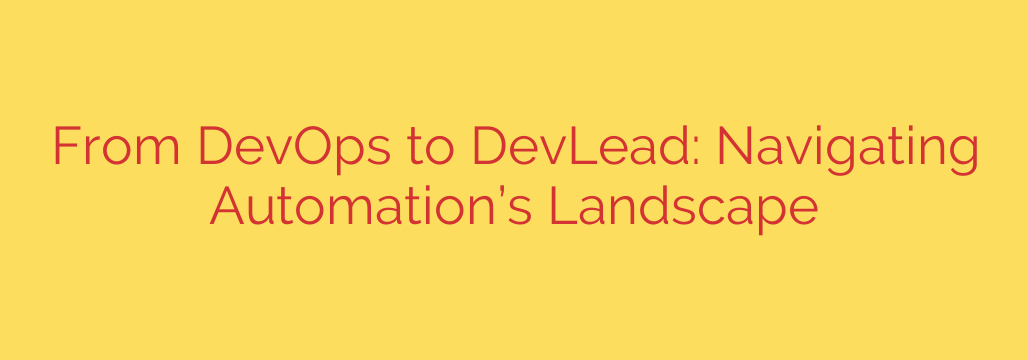
From DevOps to DevLead: Mastering the Shift from Automation to Strategy
You’ve mastered the art of the command line. You can spin up infrastructure with a single script, orchestrate complex CI/CD pipelines in your sleep, and squash production bugs before the first support ticket is filed. As a senior DevOps engineer, you are a master of automation and efficiency. But what’s next?
For many, the natural next step is a leadership role—the Development Lead, or DevLead. This transition, however, is more than just a new title. It’s a fundamental shift in perspective, moving from the person who builds the automation to the person who architects the strategy behind it. Understanding this change is the key to a successful career leap.
The Foundation: The Hands-On World of a DevOps Engineer
A DevOps engineer lives in the realm of “how.” Their primary focus is on the practical application of tools and processes to create a seamless bridge between development and operations. Success is measured by uptime, deployment frequency, and the reduction of manual effort.
Key responsibilities are deeply technical and hands-on:
- Building and maintaining CI/CD pipelines to automate testing and deployment.
- Managing infrastructure as code (IaC) using tools like Terraform or CloudFormation.
- Scripting away repetitive tasks to improve team efficiency.
- Implementing robust monitoring and alerting to ensure system health.
In this role, your expertise is in the tools themselves. You are the go-to person for fixing a broken build, optimizing a Docker image, or configuring a Kubernetes cluster.
The Leap: What Defines a Development Lead (DevLead)?
A DevLead operates in the world of “why.” While they must possess a deep technical understanding, their primary function is to guide the team, set technical direction, and ensure that engineering efforts align with broader business objectives.
The focus moves from implementing automation to defining the strategy that guides it. A DevLead asks bigger questions:
- Why are we choosing this specific cloud service over another? What are the long-term cost and maintenance implications?
- How can we standardize our automation practices across multiple teams to reduce complexity and improve security?
- What technical debt in our pipeline is creating the most significant bottleneck for our product roadmap?
- How can I mentor junior engineers to become self-sufficient in our DevOps practices?
The DevLead’s success is measured not by the code they personally write, but by the overall velocity, quality, and morale of their team.
Shifting Your Automation Mindset: From Implementer to Architect
The core of the DevOps-to-DevLead transition lies in evolving how you think about automation. It’s no longer just about solving an immediate problem; it’s about building a sustainable, scalable, and secure ecosystem.
1. From Tools to Ecosystems
A DevOps engineer masters a specific tool, like Jenkins or GitHub Actions. A DevLead, in contrast, must understand the entire toolchain as a cohesive ecosystem. They evaluate how tools integrate, identify gaps in capability, and make strategic decisions about which platforms will best serve the organization’s goals for the next three to five years. Your job is to ensure the whole is greater than the sum of its parts.
2. From Scripts to Standards
Writing a clever script to automate a task is valuable. Defining a standard for how all automation scripts should be written, documented, and version-controlled is a leadership function. A DevLead creates frameworks and best practices that empower the entire team to build high-quality automation consistently. This includes establishing patterns for IaC modules, setting guidelines for pipeline configurations, and championing code review for all automation scripts.
3. From Fixing to Forecasting
While a DevOps engineer is often reactive—fixing a failed deployment or a performance issue—a DevLead must be proactive. This means anticipating future challenges. You should be analyzing trends in build times, monitoring cloud costs, and forecasting infrastructure needs based on the product roadmap. The goal is to solve problems before they impact the team or the business.
Securing Your Automation Pipeline: A Leadership Responsibility
As you move into a leadership role, security ceases to be just another task—it becomes a foundational part of your strategy. A DevLead is responsible for embedding security into the DNA of the team’s development process, a practice often called DevSecOps.
Here are actionable security principles every DevLead should champion:
- Embed Security Early (Shift Left): Don’t wait for a final security review. Integrate automated security scanning tools directly into your CI/CD pipeline. This includes Static Application Security Testing (SAST), Dynamic Application Security Testing (DAST), and software composition analysis (SCA) to check for vulnerable dependencies.
- Enforce the Principle of Least Privilege: Your automation tools and service accounts should have only the minimum permissions necessary to perform their jobs. Regularly audit credentials and access rights, ensuring a compromised pipeline can’t lead to a catastrophic breach.
- Centralize and Secure Secrets Management: Hard-coded secrets in scripts or configuration files are a massive risk. Mandate the use of a dedicated secrets management tool like HashiCorp Vault or AWS Secrets Manager. As a leader, you are responsible for enforcing this non-negotiable standard.
- Automate Compliance and Auditing: Use automation to generate compliance reports and maintain an audit trail of all changes to infrastructure and pipelines. This not only improves security but also makes it easier to meet regulatory requirements.
Your Path to Effective Technical Leadership
The journey from a hands-on DevOps engineer to a strategic DevLead is a challenging but incredibly rewarding one. It requires letting go of the need to be the one with all the technical answers and embracing the role of a mentor, strategist, and enabler.
By shifting your focus from the “how” to the “why,” you can broaden your impact from a single command line to the entire engineering organization, driving efficiency, security, and innovation at scale.
Source: https://collabnix.com/how-to-move-from-devops-to-devlead-in-the-age-of-automation/








